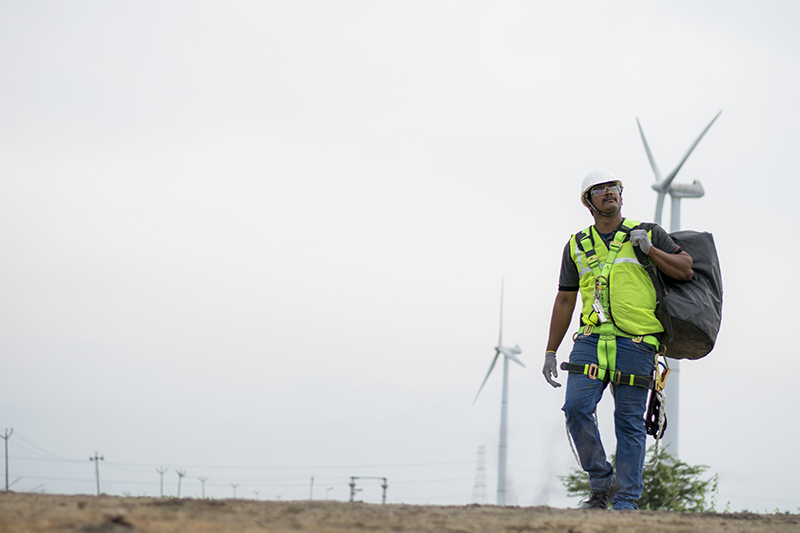GWO Training
Windcare Training Institute is now available to fulfil your GWO BST,BST Refresher and BTT needs.
The Institute is located in the wind farm region of Coimbatore which enjoys the most pleasant climate and is a very suitable place for learning safety. Our infrastructure includes ambient class rooms equipped with PA and presentation equipment and a complete set of property needed for the BST and BTT modules. Our practical training sites include a dedicated WTG Tower for GWO BST WAH module and a dedicated lab for GWO BST, not to exclude a team of tutors who have experience in the WTG work environment.
Upcoming Training Programs:
Advance Rescue Training, Lift User, Blade Repair, Sea survival

GWO Basic Safety Training
At the end of the course the participants will …
- have knowledge of hazards and risks associated with working heights, in the WTG environment
- understand the current national legislation regarding working at heights.
- Identify correct PPE, including European/Global standard markings including
- have knowledge and skills to properly inspect, maintain, store and don the relevant PPE
- demonstrate proper use of the appropriate PPE such as harnesses, lanyards, fall arresters and work positioning equipment and properly identify anchor points and correct ladder behavior.
- demonstrate correct use of evacuation devices.
- demonstrate the method of rescue in various situations in WTGs and correct use of rescue equipment.
At the end of the course the participants will …
- understand the importance of carrying out first aid in a safe way according to the legislative requirements of their geographic location, and the ERC and AHA guidelines.
- be able to identify and explain symptoms of major and minor injuries and illness related to the human body.
- understand the correct order of management in an emergency in a WTG environment.
- demonstrate the proper procedure for lifesaving First Aid using the Primary Survey A–B–C
- demonstrate proper use of an Automatic External Defibrillator (AED)
- demonstrate proper use of Ordinary First Aid and Secondary survey
- demonstrate proper use of First Aid equipment in a First Aid scenario
At the end of the course the participants will …
- have knowledge of the development and spread of fire.
- Know about the causes of fires in wind turbines and the dangers related to this.
- identify any sign of a fire in a wind turbine environment.
- Knowledge the contingency plans in a wind turbine environment including smoke detection and emergency escape procedures.
- demonstrate proper actions on discovering a fire including correct operation and fire extinguishing by means of the firefighting equipment in a WTG.
At the end of the course the participants will …
- understand the importance of carrying out work in a safe and sound manner in accordance with the legislative requirements of their geographic location.
- identify their job tasks which could increase a risk of developing muscular or skeletal injuries.
- Understand the safe practices in manual handling and correct handling of equipment.
- identify signs and symptoms of injuries related to poor manual handling techniques and know the reporting methods.
- establish a problem-solving approach to manual handling in a wind turbine environment.
- demonstrate manual handling risk reduction techniques in the WTG environment.
GWO Basic Technical Training
At the end of the course the participants will …
- Explain the main components, mechanical systems and the basic operation of wind turbines.
- Explain risks and hazards associated with mechanics.
- Understand the principles of bolted and welded connections and their inspection.
- Demonstrate practical skills to use manual tightening and measuring tools.
- Demonstrate the correct use of hydraulic torque and tensioning tools.
- Explain the principles of a gearbox.
- Explain the function of the brake systems and demonstrate how to inspect them.
- Explain the function of the yaw system and explain how to inspect it.
- Explain the function of the cooling system and demonstrate how to inspect it.
- Explain the function of the lubrication system and demonstrate how to inspect it.
At the end of the course the participants will …
- Explain the basics of electricity.
- Explain risks and hazards associated with electrical work.
- Explain the function and symbol of electrical components.
- Explain the function of different types of sensors.
- Explain and interpret a simple electrical diagram and demonstrate how to assembly it on a circuit.
- Demonstrate how to make correct and safe measurements.
At the end of the course the participants will …
- Explain the basics of hydraulics
- Explain risks and hazards associated with hydraulic work
- Explain the function of different types of pumps and demonstrate how to check start/stop pressure of a pump
- Explain the function of different types of actuators.
- Explain the function of different types of valves.
- Explain the function of accumulators and demonstrate how to check and pre-charge them.
Explain the function of different types of sensors.
- Identify the components which transfer the oil.
- Describe the handling of oil procedures.
- Identify and find different components on a hydraulic diagram.
- Demonstrate how to measure the hydraulic pressure accurately.
At the end of the course the participants will …
- Introduction to Installation
- General procedures for working onsite with installation
- Lifting operations
- Main component preparation,pre-assembly and assembly
- Principles of mechanical completion
- Principles of electrical completion including cable work
- Principles of hydraulic completion
Slinger & Signaller
At the end of the course the participants will …
- Explain of Slings
- Explain of Shackles
- Explain of Lifting bags
- Explain of Accessory storage
- Quarantine of Equipments
- Explain of Crane functions
- Explain of Lifting angles
